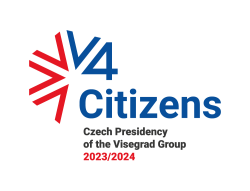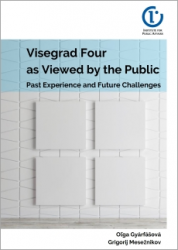
Sat 20 April 2024
Warszawa (PL)
7/5°C
| Thu | Fri | Sat | Sun | Mon |
|---|---|---|---|---|
| 8 | 10 | 9 | 6 | 9 |
Sat 20 April 2024
Praha (CZ)
5/4°C
| Thu | Fri | Sat | Sun | Mon |
|---|---|---|---|---|
| 11 | 9 | 7 | 9 | 9 |
Sat 20 April 2024
Bratislava (SK)
8/5°C
| Thu | Fri | Sat | Sun | Mon |
|---|---|---|---|---|
| 12 | 11 | 11 | 10 | 10 |
Sat 20 April 2024
Budapest (HU)
8/5°C
| Thu | Fri | Sat | Sun | Mon |
|---|---|---|---|---|
| 14 | 14 | 13 | 12 | 12 |
Freedom as a Side-product
by Sylva Poláková
After the disintegration of the Eastern Bloc many gullible people stopped thinking about what real freedom is. We satisfy ourselves with the definition of freedom of speech and free movement and in so doing we don't realise that any social system, in order to function, strives for control and disciplinary measures. The less visible the disciplinary strategies are, the more difficult it is for us to reveal that our freedom is flat and often only imaginary. In spite of this there are places where "order" does not reach or where it is no longer worthwhile to invest in "correction or punishment" (as we can see, for instance, in the technocratic Utopia of George Lucas' THX 1138, in which the pursuit of a runaway ends as soon as the set budget is exceeded). The search for places and situations where we can experience a true feeling of freedom, step over the stereotypes and emancipate ourselves, demands a high degree of empathy and the ability to take a detached view. And even when we are successful it's never for very long. A further necessity is therefore continuous transformation, which ensures escape from the "supervisor's searchlight".
Flânerie
The urban environment, which appears chaotic and at the same time includes the highest concentration of supervision technologies and strategies, provides many variants of true and imaginary free existence.
Wandering through the streets, when we let ourselves drift with the endless flow of urban impulses and attractions and at the same time retain the ability to think critically, was given the name of "flânerie" in the nineteenth century. Dawdling, as we might translate the French expression, became popular first of all among artists in Paris, who welcomed the chaotic atmosphere of the modern city as their new muse. Many artists (especially Baudelaire) and later also philosophers and theorists (let us mention at least Benjamin, who devoted his unfinished book project Passages to strolling in the city) adorned the figure of the flâneur with an aura of unique artistic talent and skills as a researcher. Flânerie, however, is not only for the "creative genius". It is the concept of a freethinker's lifestyle adapted to the urban environment. The same phenomena (architecture and town planning, communications networks and the market) that influence the transformation of cities are also reflected in various flâneur variations.
Virtual Mobility and the Headiness of Urban Attractions
At the beginning of the nineteenth century public transport and public interiors changed not only social communication, based on the enforced physical and psychological proximity to an enormous number of unknown people, but also the way of looking at things and orientation in time and space. Omnibuses brought a "mobile viewpoint" into urban life. The glazed displays of malls, department stores, exhibition halls or museums brought a concentrated visual experience of travelling. We can, however, describe as a "virtual view" any picture that we take from another medium, in other words represented "reality" simulated first of all by realistic painting and spread from the nineteenth century chiefly by photography. Films linked both. The "virtual mobility" (in the classical cinema it is only a matter of mobility in time, but in today's IMAX's it is also physical), which the film experience offers is only illusory, but extremely effective spectator practice, which definitively disturbed the classical concepts of the present and reality.
This impression of freedom, of availability and of control (or clarity), evoked by the lightness of movement and gaze, provides scope also for refined manipulation. On the one hand, then, stood intoxication with new possibilities, on the other vertigo and justified mistrust. The ambivalence of urban life is also obvious in flânerie itself, for which the city is both landscape and interior - jungle and lounge - in which we are hidden and also constantly visible to someone. For the urban loner, however, the crowd has become a place of refuge and finally also a sought-after "drug". Long aimless wanderings among the urban attractions "intoxicate" us in the end with their potency (Benjamin even uses the conceit of "hashish intoxication") until finally, as with any other addiction, we cease to be aware of the possible risk.
Searching for Cracks in the System
Is there then a risk that the satisfaction of desires will completely engulf critical and free thinking? When we stroll past the glazed displays of the shops we often succumb to the magic of the items exhibited. Between the flânerie extolled by the poets and ordinary "shopping" the difference is easily blurred at such a moment. According to Anne Friedberg, author of the book Window Shopping: cinema and the postmodern, the scenario for both activities consists of attraction, analysis and finally the satisfaction of desire, rather than need. Although shopping may appear to be more superficial, for women in the nineteenth century, for instance, it meant a whole new experience of free decision-making. The woman shopping undertook a role that she could try only with great difficulty elsewhere in the public sphere. It is no coincidence that as soon as the market awarded women their freedom as consumers (choosing and buying for herself), the whole social standing of women was set in motion. As is evident from this example, department stores, just like a visit to the cinema, where we also try other roles and identities, can evoke the impression of freedom of choice and at the same time they "help" us to spend both free time and money - just like flânerie. In the post-modern society, which has acknowledged certain qualities in mass culture, artistic and economic strategies have far more in common and need not mean only cultural decline or the curtailing of freedom.
Every effort at control and manipulation, which in the case of the market is intended to expand the ranks of consumers and increase their desires, gives rise to some sort of "side products", and in the case of department stores this was the emancipation of women.
Flânerie does not thrive in an environment that does not enable an alternative to prescribed behaviour. It cannot be inconspicuous where everything is completely clear and precisely defined, but it can quickly find itself a "crevice". If we are searching for flânerie we find its traces most easily in various creative expressions. Especially visible are those, which appear right in public spaces, such as intentionally "parasitic" street art, but also the less "independent" fields of art. In architecture, which on the contrary mainly supports the dominant ideologies, there is a tendency today to seek in the facades of buildings an old-new space for subversive and original expression. Although this initiative arises from the effort to defend one's own position and, in the case of architects, also control over the building, which might otherwise be lost literally under layers of additional advertising, in some cases forming up to ninety per cent of the outer cladding, it is far more fundamental that the newly prepared media facades give an opportunity for fleeting and non-commercial expression. According to architect Bernard Tschumi the facades are related to their environment in the sense of context: social, cultural, political or geographic. The casing may divide or unite, be militaristic or erotic, strengthen or awaken exhibitionist and voyeurial, and also flâneurial "desires". It is chiefly due to the façade that architecture is one of the symbolic systems. The surface, casing or also the skin of the building has always spoken for the architect, owner or other institution from the very start of the building of human habitations. The façade may send a certain "message" even just through the colour or the material selected. Reliefs, sgraffiti, house signs, sundials and astronomical clocks show that facades never belonged only to "advertising panels" or their earlier variations. Today the architects, together with artists, are trying to win the facades back and for this they make use of new media with the help of which they strengthen the flâneur's experience of virtual mobility.
Recently two such projects appeared on the streets of Prague. Prokop Bartoníček, within the framework of the NSA (www.networkstreetart.eu), decided to include ordinary passers-by in the appearance of the city with the aid of several projection surfaces installed on selected buildings housing various galleries, and mobile phones from which people could send their messages, which subsequently appeared on one of the projection walls. Tereza Janečková, author of the second project, gave preference to an "exhibitionistic" billboard sheet on which she printed her curriculum vitae. Her CV, in the form that is handed in for an ordinary job interview (it must be added that Janečková completed her studies at the Academy of Fine Arts [AVU] with this work, so it is to be assumed that she really is looking for a job), hung for several days on the facade of a building on Jungmannovo náměstí for the normal fee. Janečková thus managed to penetrate the environment of the big advertising campaigns. I would dare to guess that this action was a considerable shock for those passing by, reminding them that the urban environment still also belongs to them - as individuals - and not only to the impersonal consumer masses.
The Periphery is an Appeal
Both projects, however, were temporary, as opposed to a further Prague instance of a modern urban façade. The Anděl Shopping Centre in Smíchov, a glazed shopping and office complex by the French architect Jean Nouvel, is adorned with the silhouette of the melancholy figure of the Angel from Wim Wenders' film Wings of Desire. As though it should recall the dilapidated district of Smíchov, today covered over by luxurious foreign trademarks. The aesthetics of this construction, the roots of which go back to modernist iron constructions with glass outer casings, are also today in the services of economic effectiveness. The strategy of shopping centres is the simulation of the "ideal" city. Here they eliminate all the unpleasant external influences: changeable weather, traffic jams or poverty. They embody here the never fulfilled picture of the city - clean, rich, safe and well arranged. In the shopping malls and centres there is always the same climate regardless of the changing of the seasons. The way from the restaurant to the cinema, which we reach easily and quickly by means of escalators, is lined by shop windows. The detachment from natural time and reality characterised the first department stores built in the middle of the nineteenth century, but the decentralisation of the population and the development of motoring and transport networks connected with this started off a boom in the building of suburban mega shopping centres only after the Second World War. The same situation has been occurring in the last few years also in Bohemia and other countries that have revamped the "Central European" attribute. For a whole forty years the communist "Eastern Bloc" froze at the half-empty department stores. The streets ceased to be a public interior in which one was concealed. Dawdling in the streets looked "suspicious". Flânerie was replaced by gardening, bottling and do-it-yourself, which were intended to fill the gap left by "goods in short supply". Today we are thirsty to make up for these forty years and in the effort to quench this "thirst" we fall victim to shopping and building bulimia. It is worth considering whether it is time to stop dealing with the complex of a "former country from the Eastern Bloc" and accept peripherality as a specific cultural context which, although it does not promise a leading position, comes all the closer to one who is "inside and yet outside". The significance of geographical centres has been taken over by communication junctions and so the adherence to the "Central European" classification is rather a waste of energy. Urban and cultural peripheries are becoming a good investment target for projects of varied quality - but sufficient uncontrolled scope still remains within them.







